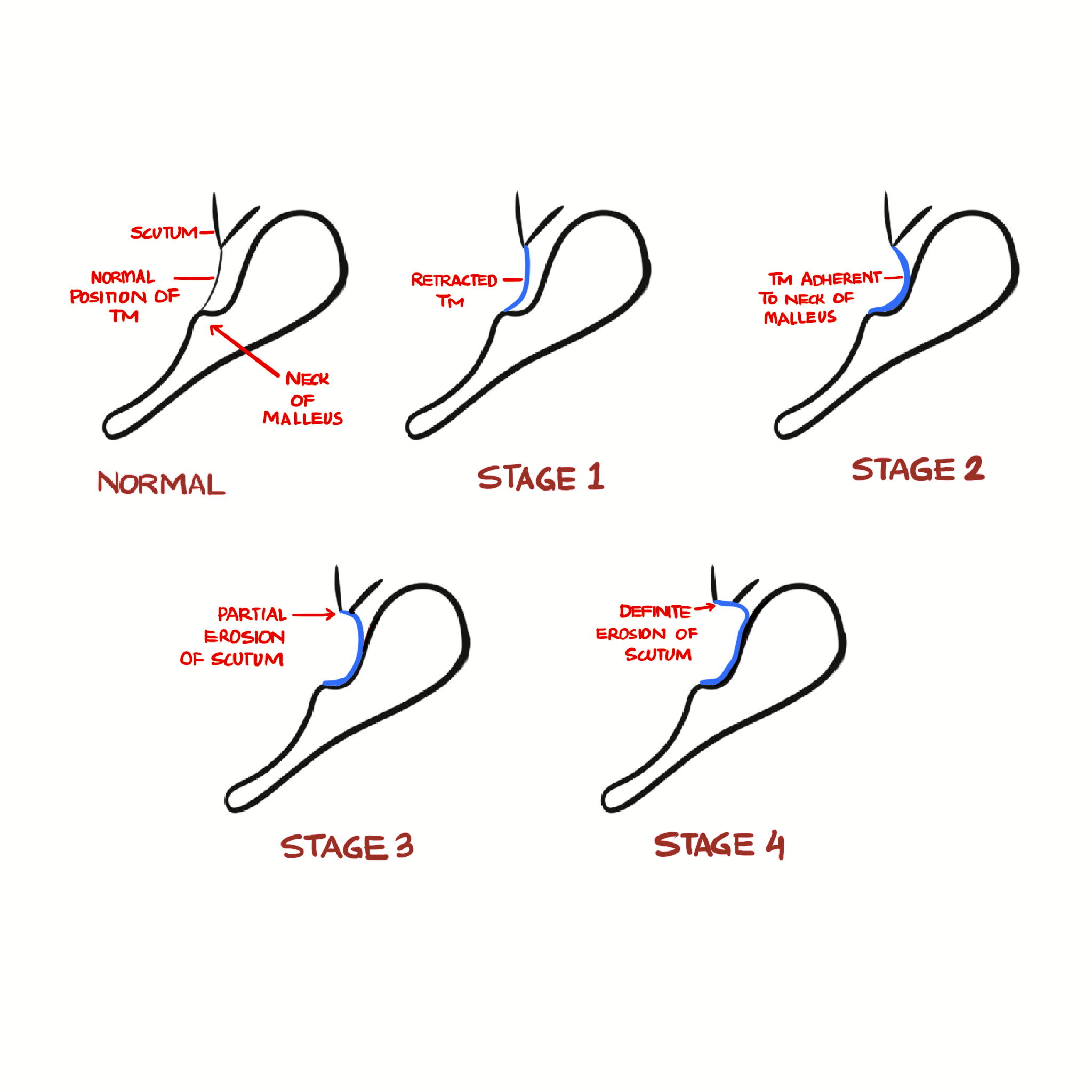Tos Classification - Pars Flaccida Retraction
💡 The post below is just an outline of the YouTube video and my notes. For the full content, please purchase the notes using the links above.
👂 Tos Classification of Pars Flaccida Retraction

✅ Stage 1: Mild Retraction
- Minimal dimpling of pars flaccida.
- Not in contact with the neck of malleus.
- Retraction is visible but not adherent.
✅ Stage 2: Contact with Neck of Malleus
- Pars flaccida is retracted and adherent to the neck of the malleus.
- Entire retraction pocket is visible on otoendoscopy.
✅ Stage 3: Partial Erosion of Scutum
- Part of the retraction pocket is out of view.
- There is partial erosion of the bony attic wall (scutum).
- The retraction is deeper and begins to hide in the attic.
✅ Stage 4: Severe Retraction and Erosion
- Severe erosion of the scutum.
- Retraction pocket is deep, not fully visible.
- Complete adherence to surrounding structures.
📝 Summary Table
| Stage | Key Features |
|---|---|
| 1 | Mild retraction, not touching malleus |
| 2 | Adherent to neck of malleus, fully visible pocket |
| 3 | Partial scutum erosion, pocket partly hidden |
| 4 | Severe erosion, deep non-visible pocket |
~~~~~~~~
📝 All the topics and questions mentioned in this post are explained in detail in my ENT notes - built for exam success and clinical understanding. Get full access by purchasing the notes.
~~~~~~~~
Related ENT Notes & Lectures
Abscesses in relation to Mastoid
Acute Mastoiditis VS Furunculosis
Acute Necrotizing Otitis Media
Acute Otitis Media - Causes, Symptoms and Treatment
Anatomy of External Ear
Anatomy of Facial Nerve
Anatomy of Facial Nerve – Branches
Anatomy of Facial Nerve – Functional Components
Anatomy of Facial Nerve – Nuclei & Course
Anatomy of Inner Ear
Anatomy of Middle Ear - Contents
Anatomy of Middle Ear - Walls & Parts
Anatomy of Tympanic Membrane
Canal wall Down VS Canal wall Up Mastoidectomy
Cholesteatoma
Chronic Suppurative Otitis Media (CSOM)
Complications of Acute Otitis Media
Complications of CSOM
Complications of Mastoidectomy
Cortical Mastoidectomy
Extracranial Complications of CSOM
Gradenigo Syndrome
How to Draw a Normal Tympanic Membrane
How to Draw Tympanic Membrane Perforations
Inner Ear fluids - Perilymph and Endolymph
Inside out VS Outside in Mastoidectomy
Labyrinthine Fistula
Labyrinthitis
Landmarks of Facial Nerve in Mastoid and Parotid surgeries
Malignant Otitis Externa (Skull Base Osteomyelitis)
Mastoiditis
Modified Radical Mastoidectomy
Organ of Corti – Anatomy, Structure and Clinical Relevance
Otogenic Brain Abscess
Petrositis
Radical Mastoidectomy
Referred Pain in the Ear
Sade Classification - Pars Tensa Retraction
Sigmoid Sinus Thrombosis
Tympanoplasty Part 1 - Definition, Types, Grafts, Indications, Contraindications
Tympanoplasty Part 2 - Approaches, Techniques, Steps & Complications
Types of Tympanoplasty - Wullstein Classification
Brodsky Grading of Tonsillar Enlargement
Indirect Laryngoscopy Diagram - How to Draw and Label
Relations of Hyoglossus Muscle